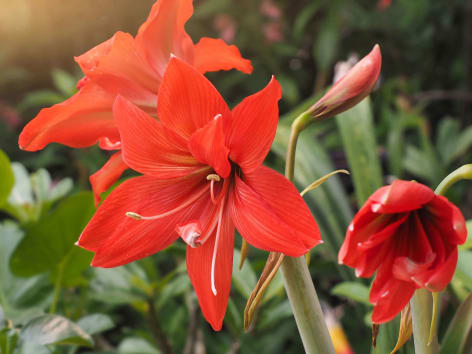Few flowers make a bigger statement indoors or out than Amaryllis. Its stunning, lily-like blooms in red, white, pink, and striped hues seem to rise out of nowhere, towering above lush green leaves. Whether forced indoors for winter color or planted outdoors in warmer climates, this bulb commands attention.
Despite its exotic look, Amaryllis is surprisingly easy to grow. With the right conditions and a little timing, you can enjoy its dramatic flowers year after year—right when you need them most.

Portrait of the Amaryllis
Though often called Amaryllis, most flowering bulbs sold under that name are from the genus Hippeastrum. Native to South America, they’ve become popular for their winter blooms, especially around the holidays.
- Type: Tender bulbous perennial
- Family: Amaryllidaceae
- Common Names: Amaryllis, Barbados Lily, Hippeastrum
Foliage and Form
Amaryllis grows from a large, papery-skinned bulb. After flowering, long, strap-like green leaves emerge to feed the bulb for the next blooming cycle.
- Height: 30–60 cm (12–24 in)
- Spread: 15–30 cm (6–12 in)
- Growth Habit: Upright, clump-forming bulb
Blooms and Fragrance
The centerpiece is its tall, sturdy stem bearing 1 to 6 massive flowers, each trumpet-shaped and often 15–20 cm (6–8 in) wide. While not all varieties are fragrant, their impact is undeniable.
- Bloom Time: December to April (indoors), spring/summer (outdoors)
- Color: Red, pink, white, salmon, bi-color, striped
- Fragrance: Mild to none (some hybrids slightly scented)
The Right Time to Plant, Prune, and Enjoy Amaryllis
| Month | Planting | Flowering | Pruning |
|---|---|---|---|
| January | ✅ Indoors (forcing) | ✅ Peak indoor bloom | ✅ Remove spent blooms only |
| February | ✅ Indoors (late bulbs) | ✅ | ✅ Cut flower stalk after blooming |
| March | ✅ Outdoors in warm zones | ✅ (late indoor) | ✅ Cut stalk, leave leaves intact |
| April | ✅ Outdoor planting in most zones | ✅ (warm climates) | ✅ Deadhead, preserve foliage |
| May | ✅ Outdoor zones 8+ | ✅ | ✅ Trim yellow leaves only |
| June | ❌ | ✅ | ❌ |
| July | ❌ | ✅ | ❌ |
| August | ❌ | ❌ | ✅ Begin dormancy (stop watering) |
| September | ❌ | ❌ | ✅ Cut leaves, store bulbs (indoors) |
| October | ✅ Re-pot for forcing indoors | ❌ | ❌ |
| November | ✅ Begin indoor forcing | ❌ | ❌ |
| December | ✅ Indoors for holiday bloom | ✅ (early bloom) | ✅ Remove wilted blooms only |
✅ = Recommended ❌ = Not advised
🌿 Dormancy tip: After flowering, allow the leaves to grow for several months before dormancy. This recharges the bulb for future blooms.
Watering, Sunlight, and Environment for Amaryllis
Watering
- Start with light watering until the shoot appears, then increase.
- After blooming, reduce watering and stop completely before dormancy.
When to Water: Weekly while actively growing
How Much: Keep soil evenly moist—not soggy
Watch for: Rot from overwatering, especially before sprouting
Sunlight
- Amaryllis needs bright, indirect light indoors and full sun outdoors.
- More sun = stronger stems and better flowers.
Indoor Placement: South or west-facing windows
Outdoor Light: Full sun to part shade
Indoor vs Outdoor
- Commonly grown indoors in pots, especially in colder zones.
- In warm climates (zones 8–11), Amaryllis thrives outdoors year-round.
Indoor Use: Winter color, gifts, windowsills
Outdoor Use: Beds, borders, and containers in mild climates
Temperature
- Prefers warmth while growing, but cool temperatures during dormancy help trigger blooms.
Optimal Range: 18–24°C (65–75°F)
Hardiness Zones: USDA 8–11
Dormancy Requirement: Cool, dark rest period (10–13°C / 50–55°F)
Ideal Soil Conditions for Growing Amaryllis
| Soil Feature | Optimal Condition | Why It Matters |
|---|---|---|
| Soil Type | Light loam or cactus mix | Ensures drainage, prevents rot |
| Texture | Loose and airy | Promotes healthy root growth |
| Drainage | Excellent, must drain freely | Prevents bulb rot |
| Moisture | Moist during growth, dry during rest | Matches natural cycle |
| Soil pH | Slightly acidic to neutral (6.0–7.0) | Promotes nutrient uptake |
| Fertility | Moderate, balanced fertilizer | Encourages strong flowers and foliage |
💡 Tip: Plant with the top third of the bulb above the soil line for best results.
Common Problems & Solutions
| Issue 🐾 | Symptoms 🔍 | Solutions 🛠️ |
|---|---|---|
| No Blooms 🌱 | Leaves only, no flowers | Needs dormant period and cool rest |
| Rotting Bulbs 💧 | Mushy, smelly bulbs | Improve drainage, reduce watering |
| Long, floppy stems 🌿 | Weak stalks | Move to brighter light |
| Yellowing Leaves 🍂 | Natural after bloom | Allow to die back gradually |
| Pests 🐜 | Spider mites, aphids indoors | Use insecticidal soap or neem oil |
Amaryllis is proof that dramatic beauty doesn’t have to be difficult. Whether you’re forcing bulbs for a midwinter bloom or planting them in your spring beds, these floral trumpets offer a burst of elegance. With just a bit of seasonal care and the right conditions, Amaryllis will reward you with spectacular flowers, year after year.